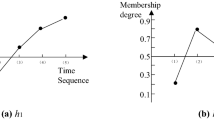Abstract
How to effectively aggregate time-series information has long been a significant issue in the field of decision-making method and decision support system. This paper studies a dynamic normal distribution stochastic decision-making method that is based on the time degree and vertical projection distance. A dynamic normal distribution number weighted arithmetic average (DNDNWAA) operator is introduced, and a time sequence weight calculation model is constructed that fully considers the subjective preference of the historical information of the decision-maker. An attribute weight-determining model based on vertical projection distance is presented against the characteristics of normally distributed stochastic variables. The original dynamic normal distribution stochastic decision-making information is aggregated via the aggregation operator under the normally distributed stochastic variables. The aggregated comprehensive stochastic decision-making information based on stochastic probability distribution theory is converted into interval numbers, and the interval number possibility degree model is applied to provide a solution ordering result. Finally, the validity and rationality of the method proposed in this paper are verified by analyzing numerical examples. The proposed method can guide decision-makers to make better decisions in dynamic random information environment.

Similar content being viewed by others
References
Maciej N (2004) Preference and vote thresholds in multi-criteria analysis based on stochastic dominance. Eur J Oper Res 158:339–350
Tan CQ, Ip WH, Chen XH (2014) Stochastic multiple criteria decision making with aspiration level based on prospect stochastic dominance. Knowl-Based Syst 70:231–241
Ronald R, Yager NA (2014) Probability weighted means as surrogates for stochastic dominance in decision making. Knowl-Based Syst 66(92–98
Prado LV, Seager TP, Chester M (2014) Stochastic multi-attribute analysis (SMAA) as an interpretation method for comparative life-cycle assessment (LCA). Int J Life Cycle Assess 19:405–416
Sajjad J, Mehdi S, Javad S, Samad A (2016) Optimizing a bi-objective reliable facility location problem with adapted stochastic measures using tuned-parameter multi-objective algorithms. Knowl-Based Syst 95:45–57
Jang GT (2014) Method for hybrid stochastic multiple attribute decision making considering decision maker’s psychological behavior. Chin J Manag Sci 22:78–84
Yu H, Liu P, Jin F (2014) Research on the stochastic hybrid multi-attribute decision making method based on prospect theory. Sci Iran 21:1105–1119
Hu J, Yang L (2011) Dynamic stochastic multi-criteria decision making method based on cumulative prospect theory and set pair analysis. Syst Eng Procedia 1:432–439
Hao JJ, Zhu JJ, Liu SF (2015) A method for multi-stage stochastic multi-criteria decision making concerning prospect theory. Chin J Manag Sci 1:73–81
Li CB, Zhang JY, Gu YD, Qi ZQ (2015) Method for fuzzy-stochastic multi-criteria decision-making based on prospect theory and improved TOPSIS with its application. Oper Res Manag Sci 2:92–100
Liang X, Jiang YP (2015) Method of stochastic multi-attribute decision making with 2-tuple aspirations considering regret behavior. J Syst Eng 30:719–727
Xu ZS (2008) On multi-period multi-attribute decision making. Knowl-Based Syst 21:164–171
Xu ZS, Yager RR (2008) Dynamic intuitionistic fuzzy multiple attribute decision making. Int J Approx Reason 48:246–262
Sadiq R, Tesfamariam S (2007) Probability density functions based weights for ordered weighted averaging (OWA) operators: an example of water quality indices. Eur J Oper Res 182:1350–1368
Yang ZL, Huang LC (2017), Dynamic stochastic multi-attribute decision-making that considers stochastic variable characteristics under time-sequence contingency environments, Math Probl Eng 7126856, 9 p
Chen W, Li JQ (2017) Evaluation of risk management capability of partners in R&D projects based on error propagation and orthogonal projection. J Intell Fuzzy Syst 32:4419–4429
Wei GW (2011) Gray relational analysis method for intuitionistic fuzzy multiple attribute decision making. Expert Syst Appl 38:11671–11677
Dymova L, Sevastjanov P (2014) A new approach to the rule-base evidential reasoning in the intuitionistic fuzzy setting. Knowl-Based Syst 61:109–117
Iancu C (2014) Intuitionistic fuzzy similarity measures based on Frank t-norms family. Pattern Recogn Lett 42:128–136
Wang JQ, Li KJ, Zhang HY (2012) Interval-valued intuitionistic fuzzy multi-criteria decision-making approach based on prospect score function. Knowl-Based Syst 27:119–125
Qin JD, Liu XW, Pedrycz W (2015) An extended VIKOR method based on prospect theory for multiple attribute decision making under interval type-2 fuzzy environment. Knowl-Based Syst 86:116–130
Joshi D, Kumar S (2015) Intuitionistic fuzzy entropy and distance measure based TOPSIS method for multi-criteria decision making. Egypt Inform J 15:97–104
Chen TY (2015) The inclusion-based TOPSIS method with interval-valued intuitionistic fuzzy sets for multiple criteria group decision making. Appl Soft Comput 26:57–73
Chen SM, Cheng SH, Lan TC (2016) Multi-criteria decision making based on the TOPSIS method and similarity measures between intuitionistic fuzzy values. Inf Sci 367–368:279–295
Yue ZL (2014) TOPSIS-based group decision-making methodology in intuitionistic fuzzy setting. Inf Sci 277:141–153
Cao QW, Wu J, Liang CY (2015) An intuitionistic fuzzy judgment matrix and TOPSIS integrated multi-criteria decision making method for green supplier selection. J Intell Fuzzy Syst 28:117–126
Wang XF, Yang XJ (2010) Dynamic stochastic multiple attribute decision making method with incomplete certain information. Syst Eng Theory Pract 2:332–338
Shannon CE (1948) A mathematical theory of communication. Bell Syst Tech J 27(379–423):623–656
Guo YJ, Yao Y, Yi PT (2007) A method and application of dynamic comprehensive evaluation. Syst Eng Theory Pract 27:154–158
Yager RR (1988) On orderedweight averaging aggregation operators in multi-criteria decision making. IEEE Trans Syst Man Cybern 18:183–190
Hua XY, Tan JX (2004) Revised TOPSIS method based on vertical projection distance-vertical projection method. Syst Eng Theory Pract 1:114–119
Hu JH, Zhang Y, Chen XH, Liu YM (2013) Multi-criteria decision making method based on possibility degree of interval type-2 fuzzy number. Knowl-Based Syst 43:21–29
Liu BS, Shen YH, Zhang W (2015) An interval-valued intuitionistic fuzzy principal component analysis model-based method for complex multi-attribute large-group decision-making. Eur J Oper Res 245:209–225
Funding
This research was supported by the Natural Science Foundation of China (Grant No. 71704007) and the China Postdoctoral Science Foundation Funded Project (Grant No. 2016M600889).
Author information
Authors and Affiliations
Corresponding author
Rights and permissions
About this article
Cite this article
Yang, Z., Chang, J. Solving dynamic normal distribution stochastic decision-making problems based on time degree and vertical projection distance. Pers Ubiquit Comput 22, 1153–1163 (2018). https://doi.org/10.1007/s00779-018-1148-z
Received:
Accepted:
Published:
Issue Date:
DOI: https://doi.org/10.1007/s00779-018-1148-z




